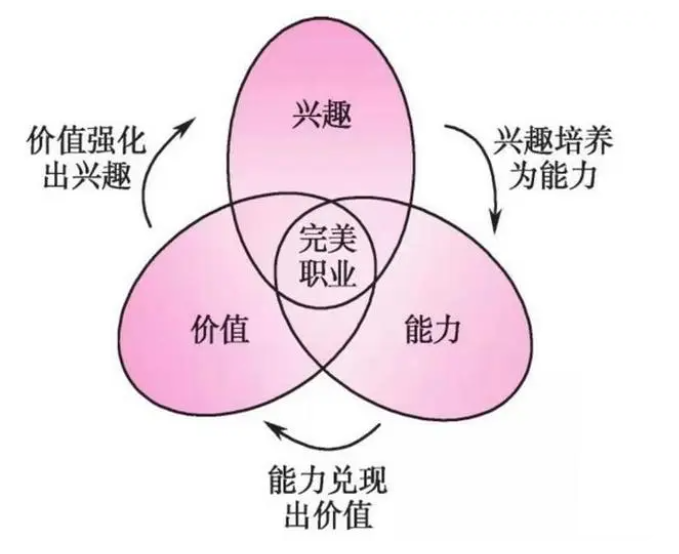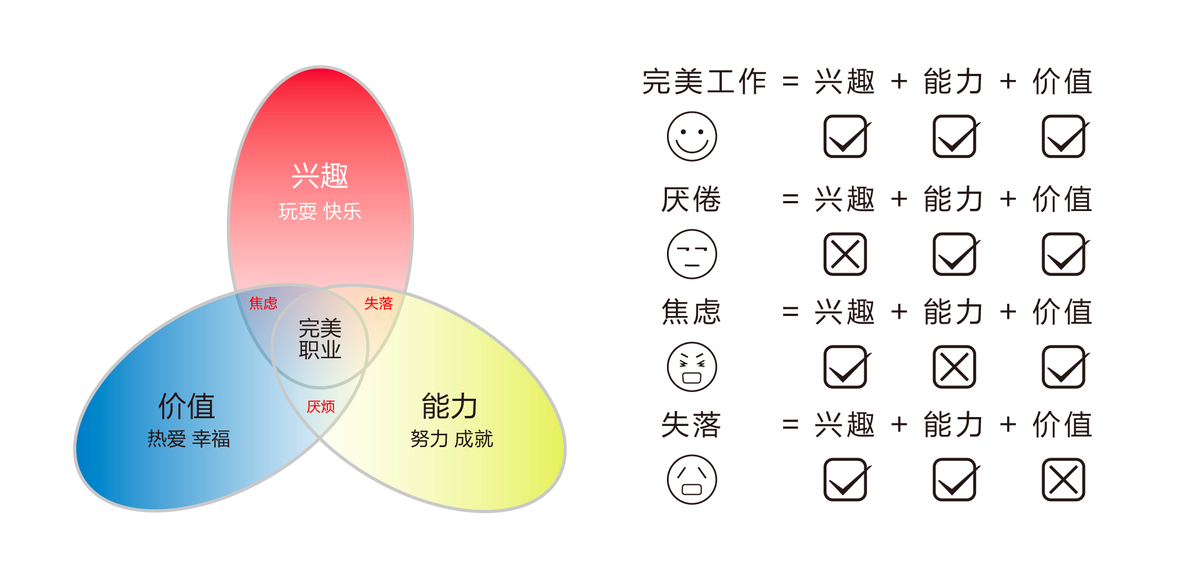In the workplace, many people will encounter problems such as career confusion, unclear development direction, work burnout or career anxiety. As a practical career planning tool, the Clover model can help us comprehensively evaluate the current career status and find a balance point for long-term development from the three core dimensions of 'interest', 'ability' and 'value'. Combined with career planning psychological tests (such as MBTI, Holland Career Interest Test, etc.), we can formulate career development strategies more accurately and get out of the dilemma.
What is the professional Clover model?
The occupational clover model consists of three core elements: interest, ability and value :
- Interest : Your enthusiasm for a certain job or field is the inherent driving force that drives long-term investment.
- Ability : Your knowledge, skills and experience in your work are the key to turning interests into results.
- Value : Material rewards and spiritual satisfaction brought by work, such as salary, sense of accomplishment, social identity, etc.

When the three are balanced, a virtuous cycle will be formed: interest-driven learning → enhance ability → create value → enhance interest . However, once it is unbalanced, it is prone to problems such as burnout and stagnation of development.
How to combine occupational psychology tests for self-assessment?
Before using the career clover model, you can first use some popular career planning psychological assessments to quickly understand your interests, abilities and value tendencies:
1. MBTI Career Personality Test (Myers-Briggs Type Indicator): Analyze your career adaptation direction from a personality dimension to help clarify the appropriate work type and environment. 2. Holland Code / RIASEC: Divide career interests into six types (realistic, research-oriented, artistic, social, corporate, and conventional), and are often used for career direction selection. 3. DISC personality test : analyze your communication style, work style and team roles, and provide reference for career development and teamwork. 4. Enneagram Personality Test : Get an in-depth understanding of your inner motivation, behavioral patterns, and career strengths. 5. PDP career personality test : helps discover personal core strengths and optimize career path planning.
After doing these professional personality tests, the results can be combined with the clover model to analyze the matching degree between the three elements.
Further reading:
- Free personality test recommendations except MBTI test: 30+ online personality test collection
- How is DISC testing different from PDP, MBTI, and Holland testing? How to choose the right test?
- Career planning must-have: The most comprehensive guide to career personality assessment tools
The mechanism of action of the occupational clover model
The model emphasizes the cycle of mutual promotion of three elements: interest → ability → value → interest
When you are full of interest in work, you will actively learn to improve your skills; after you improve your abilities, you can create more value and gain recognition; after you get rewards, you will further enhance your career enthusiasm.

Common types and solutions for model imbalance
1. Loss of interest (burnout)
Performance : bored with work, lack of motivation, and decreased efficiency.
suggestion :
- Do the MBTI career personality test or the Enneagram personality test to re-confirm the area of interest.
- Set new challenges or study plans for yourself.
- Consider horizontal transfer or explore side job interests.
2. Inadequate ability (career anxiety)
Performance : Excessive pressure and lack of control.
suggestion :
- Learn your work style through DISC testing and find the most effective way to learn.
- Formulate a capacity improvement plan (training, project practice, mentor guidance).
- First master the core skills, then gradually expand the field.
3. Lack of value (low sense of professional significance)
Performance : Feeling that work is meaningless and has low returns.
suggestion :
- Match positions that are more in line with values through the Holland interest test .
- Find value creation opportunities in existing positions (innovate, optimize processes, and assume more influential tasks).
- Assess and adjust career direction in a timely manner.
4. All three elements are missing (occupational crisis)
Performance : Interest, ability and value have declined across the board.
suggestion :
- Priority is given to comprehensive career assessments to clarify core advantages and potential interests.
- Start rebuilding confidence and motivation from small goals.
- Consider career transformation or continuing education.
Application scenarios of the Clover Model
- Career Planning and Development Path Design
- Performance Communication and Employee Motivation
- Guidance on job transfer and career transformation
- Burnout intervention
- Strategies for resignation and career retention
In these scenarios, combining professional interest testing and ability assessment tools can make the analysis more accurate and the plan more implementable.
6. Supplementary of the dual-line model of career development
In addition to the Clover model, you can also refer to the career development dual-line model :
- Work line : tends to be stable and guarantee (salary, welfare, life balance).
- Career line : tend to achievement and challenges (interest-driven, value realization, influence).
The two lines can alternate or parallel to help achieve a long-term balance between career and life.
Conclusion
The occupational Clover model provides us with a scientific career self-assessment framework . Combined with the results of career psychology tests , we can find career direction more accurately, improve our abilities, and enhance our sense of value.
Whether you are a newcomer in the workplace, a backbone in the promotion stage, or a senior practitioner who is considering transformation, you can use this model and testing tool to find your own career balance point .
Link to this article: https://m.psyctest.cn/article/jNGebl5M/
If the original article is reprinted, please indicate the author and the source in the form of this link.

